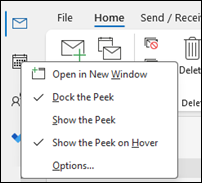Change how you view your Outlook calendar
Select a tab option below for the version of Outlook you're using. What version of Outlook do I have?
Note: If the steps under this New Outlook tab don't work, you may not be using new Outlook for Windows yet. Select Classic Outlook and follow those steps instead.
In Outlook, you have the option to:
Change view | Change to Monday start | Change work week | View two time zones
Change to Day, Work Week, Week, or Month view
-
On the navigation bar, select Calendar.
-
On the Home tab, select the view you want.

Change the calendar view with a Monday start
-
Select Calendar.
-
In the View tab, select Calendar settings.
-
Under Calendar appearance, select the drop down under Show the first day of the week as: and select Monday.
-
Select Save.
Change Work Week view (non-traditional work week)
-
Select Calendar.
-
In the View tab, select Calendar settings.
-
Under Show work week as: select the days of your work week.
-
Select Save.
View two time zones in the Calendar view
-
Select Calendar.
-
In the View tab, select Calendar settings.
-
Select Add time zone.
-
In the Other time zones list, select the time zone you'd like to add.
-
Type a location or time zone in the Label box.
-
Select Save.
Keep upcoming calendar items visible
Keep your upcoming appointments and meetings in view by opening the Calendar peek on the side of your Mail.
From either Mail or Calendar, right-click Calendar on the Navigation Bar, and then select Dock the peek.

Note: To Dock the peek for both Mail and Calendar, you need to select the option for each one individually.
Learn more about keeping your calendar, appointments, and meetings always in view.
Change to Month view with a Monday start date and show U.S. holidays
View the Calendar by month to see what you are doing at-a-glance. A common way to view the calendar is by setting the work week to start on a Monday, with U.S. holidays.
-
Select Calendar.
-
Select Home > Arrange > Month.
-
Select the File tab.
-
Select Options, and then Calendar.
-
Under Work time, for First day of week, select Monday.
-
Under Calendar options, for Add holidays to the Calendar, select Add Holidays.
-
Select United States, and then OK.
Learn more about adding holidays to your calendar.
Change Work Week view to Sunday-Tuesday with 12-hr days (non-traditional work week)
If you work a non-traditional work schedule, you can set your Work Week view to only show those working times. For example, if you are a nurse, you may only want to view your Sunday – Tuesday, 12-hour shift at the hospital.
-
Select Calendar.
-
Select Home > Arrange > Work Week.
-
Select the File tab.
-
Select Options, and then Calendar.
-
Under Work time, for Start time, select 6:00 AM.
-
Under Work time, for End time, select 6:00 PM.
-
For Work week, select Sun, Mon, and Tue and clear any other selected check boxes.
-
For First day of week, select Sunday.
-
Select OK.
Tip: To view all your hours during a long shift in the Work Week view, use Zoom in the bottom corner of the Calendar to make it smaller.
View two time zones in the Week view
When working with partners in different time zones, it’s helpful to see both time zones in the Week view. For example, when scheduling meetings from an Eastern time zone, you can view an Australian co-worker's schedule (Brisbane time zone) so you don’t book during non-working hours.
-
Select Calendar.
-
Select Home > Arrange > Week.
-
Select the File tab.
-
Select Options, and then Calendar.
-
Under Time zones, type Eastern Time Zone in the Label box.
-
In the Time zone list, select (UTC-05:00) Eastern Time (US & Canada).
-
Select Show a second time zone.
-
Type Brisbane in the Label box.
-
In the Time zone list, select (UTC+ 10:00) Brisbane.
-
Select OK.
Learn more about how time-zone normalization works.
Looking for something else?
If you find yourself filtering calendar items or modifying fields, you can easily create a custom view so the information you need is always available.
-
Select View.
-
In the Current View group, select Change View, and then Manage Views.
-
Select New.
-
In the Name of new view box, type a name for the view.
-
In the Type of view box, select a view type.
-
To change where the view is available, select an option under Can be used on, and then select OK.
-
In the Advanced View Settings: New View dialog box, select the options that you want to use.
-
When you are finished selecting options, select OK.
-
To use the view immediately, select Apply View.
Learn more about changing or customizing a view.














